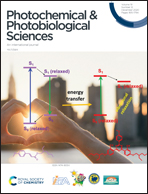New modeling of 3D quaternary type BaCuZnS-graphene-TiO2 (BCZS-G-T) composite for photosonocatalytic hydrogen evolution with scavenger effect†
Abstract
For the efficient evolution of hydrogen, we designed a 3D quaternary BaCuZnS-graphene-TiO2 (BCZS-G-T) composite by an ultrasonic method. Herein, we prepared a quaternary material to minimize the bandgap energy and size. We characterized the “as-prepared” composites by X-ray diffraction (XRD), scanning electron microscopy (SEM) with energy dispersive X-ray (EDX) analysis, transmission electron microscopy (TEM), X-ray photoelectron spectroscopy (XPS), UV-vis diffuse reflectance spectroscopy (DRS), photoluminescence (PL) spectroscopy, and electrochemical impedance spectroscopy (EIS). The high hydrogen evolution was attributed to the 3D quaternary BCZS-G-T composite with small bandgap energy because of its high photoelectron recombination properties. In addition, we demonstrated the combination effects with photocatalytic and sonocatalytic treatments with a scavenger. This work highlights the potential application of quaternary graphene-based composites in the field of energy conversion.



 Please wait while we load your content...
Please wait while we load your content...